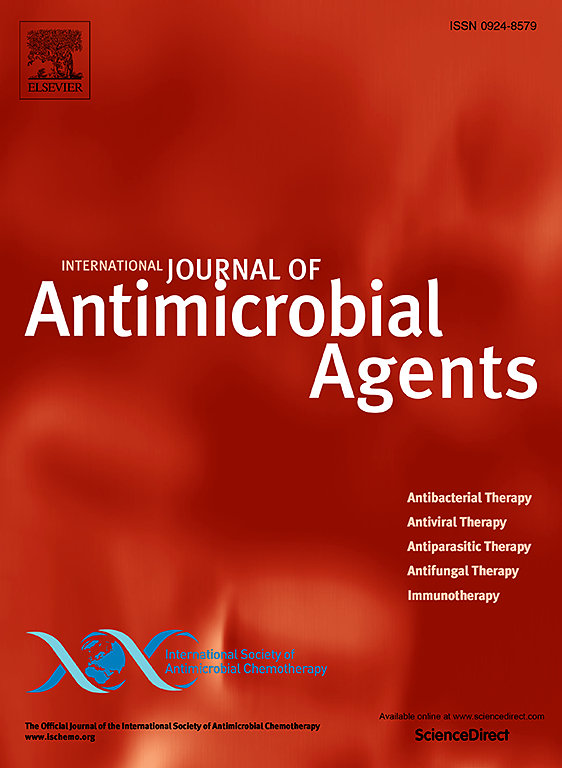A review of recently discovered mechanisms of cephalosporin resistance in Pseudomonas aeruginosa
IF 4.6
2区 医学
Q1 INFECTIOUS DISEASES
International Journal of Antimicrobial Agents
Pub Date : 2025-04-28
DOI:10.1016/j.ijantimicag.2025.107527
引用次数: 0
Abstract
Pseudomonas aeruginosa frequently causes respiratory tract infections in immunocompromised patients as well as bloodstream, urinary tract, skin, and soft tissue infections. The increasing prevalence of multidrug-resistant P. aeruginosa strains poses a significant clinical challenge. Cephalosporin antibiotics from the β-lactam class are commonly prescribed to treat infections owing to their broad spectrum of activity and generally low host toxicity. P. aeruginosa utilizes β-lactamase enzymes, efflux pumps, and mutations in outer membrane porins/transporters and target proteins, all of which confer resistance to cephalosporin antibiotics.
This review categorizes resistance mechanisms into (i) well-characterized pathways, such as AmpC β-lactamase and Mex efflux pumps, (ii) recently described mutations linked to cephalosporin resistance (e.g., ygfB, sltB1, pbp3, galU, pmrAB, fusA1, and gyrA), and (iii) hypothetical β-lactamases and other mechanisms requiring further validation.
A variety of β-lactamase inhibitors have been developed to overcome β-lactamase-mediated resistance, but resistance has already been observed toward inhibitors via the accumulation of mutations within the targeted β-lactamase enzyme or increased activity of efflux pumps.
Understanding the regulation and pathways that lead to resistance is crucial in developing effective strategies to combat P. aeruginosa infections and extending the therapeutic lifespan of cephalosporin antibiotics.

最近发现的铜绿假单胞菌头孢菌素耐药机制综述。
铜绿假单胞菌经常引起免疫功能低下患者肺部的呼吸道感染以及血液、尿路、皮肤和软组织感染。越来越多的耐多药铜绿假单胞菌菌株的流行对临床提出了重大挑战。β-内酰胺类头孢菌素抗生素由于其广谱活性和通常较低的宿主毒性,通常用于治疗感染。然而,铜绿假单胞菌利用四类β-内酰胺酶来分解头孢菌素、将抗生素排出细胞的外排泵以及外膜孔蛋白/转运蛋白和靶蛋白的突变,所有这些都赋予了耐药性。本综述将耐药机制分为:1)特征明确的途径,如AmpC β-内酰胺酶和Mex外排泵;2)最近描述的与头孢菌素耐药相关的突变(如ygfB、sltB1、pbp3、galU、pmrAB、fusA1和gyrA); 3)假设的β-内酰胺酶和其他需要进一步验证的机制。各种β-内酰胺酶抑制剂已经被开发出来以克服β-内酰胺酶介导的耐药性,但是已经观察到通过靶向β-内酰胺酶内突变的积累或外排泵活性的增加对抑制剂的耐药性,如本文所述。了解导致耐药性的调控和途径对于制定有效的策略来对抗铜绿假单胞菌感染和延长头孢菌素类抗生素的治疗寿命至关重要。
本文章由计算机程序翻译,如有差异,请以英文原文为准。
求助全文
约1分钟内获得全文
求助全文
来源期刊
CiteScore
21.60
自引率
0.90%
发文量
176
审稿时长
36 days
期刊介绍:
The International Journal of Antimicrobial Agents is a peer-reviewed publication offering comprehensive and current reference information on the physical, pharmacological, in vitro, and clinical properties of individual antimicrobial agents, covering antiviral, antiparasitic, antibacterial, and antifungal agents. The journal not only communicates new trends and developments through authoritative review articles but also addresses the critical issue of antimicrobial resistance, both in hospital and community settings. Published content includes solicited reviews by leading experts and high-quality original research papers in the specified fields.

 求助内容:
求助内容: 应助结果提醒方式:
应助结果提醒方式:


